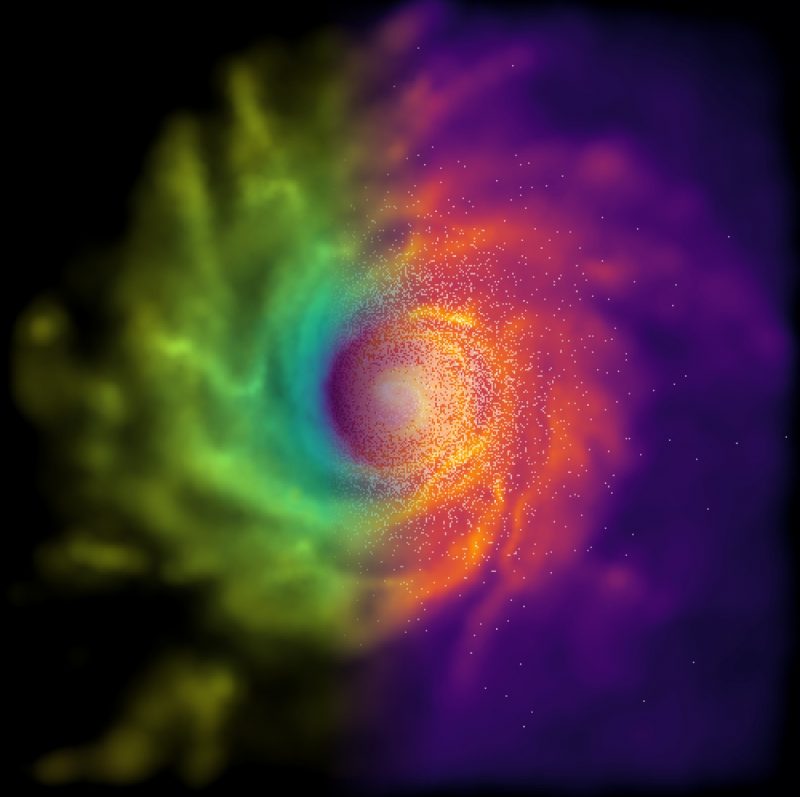
Since the early 1900s, Einstein’s theory of gravity – called the general theory of relativity – has dominated the theories and calculations of cosmologists, those who explain the workings of our universe as a whole. General relativity has been proven again and again, most recently with the first direct black hole image. Now, physicists at Durham University in the U.K. say that Einstein’s general theory of relativity might not be the only way to explain how gravity works or how galaxies form. They’ve had dramatic research success with an alternative model for gravity – f(R)-gravity – called a Chameleon Theory, because, in their words, “it changes behavior according to the environment.” They say this Chameleon Theory is an alternative to general relativity in explaining the formation of structures in the universe. It might also help further understanding of dark energy, a mysterious substance thought to be accelerating the expansion rate of the universe.
The images on this page were released July 8, 2019, by physicists Christian Arnold, Matteo Leo and Baojiu Li, all of of Durham University’s Institute for Computational Cosmology. They’re the results of recent computer simulations run on the DiRAC Data Centric System at Durham University. The simulations show that galaxies like our Milky Way could still form in the universe even with different laws of gravity. Earlier work had shown that theoretical calculations using Chameleon Theory reproduce the success of general relativity on the relatively small scale of our solar system. The Durham team has now shown that this theory allows for realistic simulations of large-scale structures like our Milky Way. Research co-lead author Christian Arnold, said:
Chameleon Theory allows for the laws of gravity to be modified so we can test the effect of changes in gravity on galaxy formation. Through our simulations we have shown for the first time that even if you change gravity, it would not prevent disk galaxies with spiral arms from forming.
Our research definitely does not mean that general relativity is wrong, but it does show that it does not have to be the only way to explain gravity’s role in the evolution of the universe.
The findings are published in the peer-reviewed journal Nature Astronomy.

A statement from these researchers explained more about their recent study:
The researchers looked at the interaction between gravity in Chameleon Theory and supermassive black holes that sit at the center of galaxies. Black holes play a key role in galaxy formation because the heat and material they eject when swallowing surrounding matter can burn away the gas needed to form stars, effectively stopping star formation.
The amount of heat spewed out by black holes is altered by changing gravity, affecting how galaxies form. However, the new simulations showed that even accounting for the change in gravity caused by applying Chameleon Theory, galaxies were still able to form.
These physicists said their work might also shed light on our understanding of the observed accelerating expansion of the universe. Scientists believe this expansion is being driven by dark energy, and the Durham researchers say their findings could be a small step toward explaining the properties of this substance. Research co-lead Baojiu Li commented:
In general relativity, scientists account for the accelerated expansion of the universe by introducing a mysterious form of matter called dark energy – the simplest form of which may be a cosmological constant, whose density is a constant in space and time. However, alternatives to a cosmological constant which explain the accelerated expansion by modifying the law of gravity, like f(R) gravity, are also widely considered given how little is known about dark energy.
The Durham researchers are theoretical physicists, as Einstein was. When Einstein’s general theory of relativity was first proven – during a total solar eclipse of 1919 – Einstein was catapulted into rock star fame. Now general relativity is fundamental to modern cosmology. The next step for Chameleon Theory would likewise be to test and hopefully confirm it via observations. There’s no doubt but that observational astronomers will soon be on the job, creating their own tests for the new Chameleon Theory, and perhaps proving it. If and when that happens, it’ll be super exciting!

Bottom line: The new Chameleon Theory has the potential to become an alternate theory of gravity, working alongside Einstein’s theory of general relativity. Recent computer simulations show that the theory can be used to recreate large-scale structures (galaxies) in our universe.
Source: Realistic Simulations of Galaxy Formation in f(R) Modified Gravity











